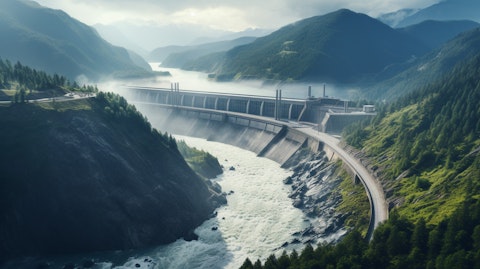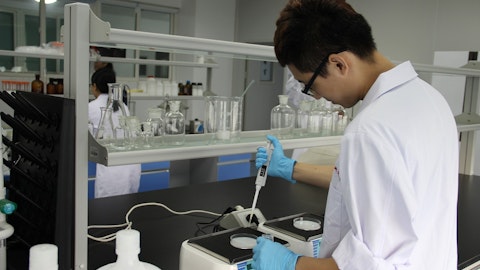Centrais Elétricas Brasileiras S.A. – Eletrobrás (NYSE:EBR) Q1 2025 Earnings Call Transcript May 15, 2025
Centrais Elétricas Brasileiras S.A. – Eletrobrás misses on earnings expectations. Reported EPS is $0.07 EPS, expectations were $0.16.
Operator: Good morning, ladies and gentlemen, and welcome to Eletrobrás’ Conference to discuss the Results for the First Quarter 2025. Here with us today are Mr. Ivan de Souza Monteiro, the President of Eletrobrás; Mr. Eduardo Haiama, Executive Vice President for Finance and Investor Relations; Mr. Antônio Varejão de Godoy, Vice President for Operations and Safety; Ms. Camila Araújo, Vice President for Governance, Risk Compliance and Sustainability; Mr. Elio Wolff, Vice President for Strategy and Business Development; Mr. Italo Freitas, Vice President for Trading; Mr. Juliano Dantas, Vice President for Innovation R&D, Digital and IT; Mr. Marcelo de Siqueira Freitas, VP for Legal Affairs; Mr. Renato Carreira, Vice President for Procurement and Services and Interim Vice President for People Management and Culture; Mr. Robson Pinheiro Rodrigues de Campos, Vice President for Expansion Engineering; Mr. Rodrigo Limp, Vice President for Regulation and Institutional Relations.
We would like to inform you that this event is being recorded and will be made available on the company’s IR website, along with the presentation being shared today, both in Portuguese and English. For those who require simultaneous translation, the tool is available via the globe icon labeled interpretation at the bottom center of your screen. Please choose your preferred language. For those listening to the video conference in English, there is an option to mute the original audio. For the Q&A session, if you wish to pose a question, please provide your name and company through the Q&A icon at the bottom of your screen. As per our standard procedure, your name will be announced so that you can ask your question live. At that time, a request to unmute your microphone will appear on your screen.
Should you prefer not to use the microphone please write your name and company followed by your question in the QA field, so that the operator can read it aloud. Before we proceed, we would like to clarify that any statements made during this conference regarding the company’s business outlook, projections, operational and financial goals constitute the beliefs and assumptions of Eletrobrás’ executive management and information currently available to the company. Forward-looking statements are not guarantees of performance as they involve risks and uncertainties and therefore, depend on circumstances that may or may not occur. Investors should understand that general economic conditions and other operational factors may affect the results expressed in such forward-looking statements.
We will now turn the floor over to Mr. Ivan Monteiro, President of Eletrobrás, will begin the presentation.
Ivan de Souza Monteiro: Good morning, everybody. Welcome to the earnings release of Eletrobrás for the first quarter 2025. We have two important highlights. The conciliation between the federal government and the search for a constant dialogue that we initiated with them after a year and a half of negotiations, we had approval and support of the general shareholders assembly. Another mark is the new collective bargaining agreement, a relevant tool, so that we can continue enhancing our cost and processes. We had very high availability of our generation and transmission equipment this quarter looking for operational excellence and extreme reliability of operation. Now, yesterday, there was a partial sale of our gas supply plants.
Now generation is getting to 100% based on water, sun and wind generation. In transmission, I draw your attention to the conclusion of the Coxilha plant and the advances in Manaus-Boa Vista. We confirm the expectation of conclusion of this work for second semester of 2025. As part of the conciliation agreement, we have made investments for the conclusion of the Angra nuclear plant. We will not have to generate anything for the conclusion of this project or make new investments in Angra dos Reis Park. We will continue to pursue the sale of our stake in the nuclear plant, a process we began at the end of 2023. I would like to confirm that we’re pursuing a recurrent PMSO figure for the year 2025. We have also made significant strides in training with an advance in volume, stability of processes, a good relationship, offering solutions and energy to an ever greater number of customers.
I would like to thank you and turn the floor over to Mr. Haiama.
Eduardo Haiama: We’re going to go on to Slide number 3 where we will feel about our financial performance for the first quarter and I will speak about the management of energy trading as well. So we go to the highlights on Slide number 5. The main highlight has already been remarked by Mr. Monteiro, we concluded the discussions with the government and have proved the agreement at the shareholders assembly. Secondly, we have a partial conclusion of the sale of Amazon thermal plants receiving R$2 billion in our cash. Now on Slide number 6. Regarding our results, we have adjusted results, loss of R$81 million, where the main impact comes from the regulatory remeasurement of Chesf for transmission, another highlight. Since the negotiation with the thermal plant, we have stopped the problem of default and Amazonas Energia in such a way that the default was R$56 million in the first quarter compared to R$432 million in the first quarter 2024.

A reduction in operational costs with a drop of 28% vis-a-via the fourth quarter 2024, and 8% year-on-year with savings of R$143 million in personnel. In energy trading, an increase in the free market year-on-year of 35%. On Slide number 7 regarding PMSO optimization, we had a drop of 28% vis-à-vis the fourth quarter, 8% year-on-year, and you see a consistent reduction in PMSO with a highlight for the drop of 15% in our personnel costs. Therefore, the annualized cost for the first quarter is somewhat below R$6 million in 2025. As we had remarked in the fourth quarter, this seasonality that occurred in the fourth quarter. For this year, we have implemented some changes precisely to mitigate this effect. So part of this cost in the first quarter already reflects that the seasonality and this cost should remain throughout the year.
On Slide number 8, compulsory loan with a reduction in the first quarter R$400 million, last year a drop of almost R$300 million. Now above and beyond the R$400 million, we had a reduction of R$336 million in the possible and remote settlements. On Slide number 9, we look at our financial figures. Revenue growing 16%, relatively flat in the regulatory, and it’s important to recall that after the tariff revision that took place last year, the transmission revenue had a drop offsetting the generation revenues in EBITDA, a drop and we go straight to the regulatory adjusted figures, a drop of 4% partially due to the transmission revenues and partly due to a drop not only in the average sales price of ACL quarter-on-quarter, but also a greater sales exposure in the Southeast, not fully offset by volumes in the North and Northeast.
On Slide number 10, we show you our profit dynamic. We had losses of R$81 million compared to R$354 million, and this is due to the regulatory remeasurement at Chesf impacting, of course, the result. On Slide number 11, our operating provisions. We continue to improve our provisions in general. The highlight once again is the issue of Amazonas. Since the sale agreement with thermal plants, we have reduced the default, the recurring default of the company for PCLD. And in terms of litigations, once again, a change in constitution and withdrawals we carried out through time. Thanks to all of the agreements we have reached. On Slide number 12, a highlight for the sale of thermal power plants. We’re receiving R$2.9 billion in cash for the partial sale.
We’re still missing Santa Cruz that is pending approval. Now with that, based on our thermal capacity, we have a reduction of 0.6 megawatts of installed capacity, and we’re on that trajectory for net zero as our commitment for 2030 in the ESG agenda. On Slide 13, we launched our sustainability report for 2024. We continue with the partnership with Estapar for electrical cars and some parking lots, the agreement with Antaq to promote decarbonization in ports and waterway terminals and in terms of social, environmental and cultural commitment the reconstruction of the national museum that had caught fire a few years ago and we had the surprise of the birth of the first Amazonian manatee calf in five years at Eletrobrás preservation center. On Slide Number 15 we’ll see speak about our energy trading.
On Slide 15 we show you that in 2025 our balance is between 0 and 2.5 gigawatts. We continue to enhance the sales in 2026-2027. As a result of the price dynamic that we observe, it has changed levels when we compare it with ‘23 and the beginning of 2024 when we began to observe volatility impacting the futures market. Therefore, we’re accelerating our sales in places where we believe we have a more fair price. We reached 722 customers, a growth of 35% year-on-year. On Slide 16 simply to help you to understand where our resources lie, our generation capacity, where all of our long-term procurement lies, momentary procurement that we need because of trading or structural issues, and where we are allocating that energy presently for the long-term and for the short-term as well.
As an example, we have 17 GW in the slide to the left of total capacity. We’re acquiring 800 MG. So we will have 18 gigawatts to trade through time. Of those 18 gigawatts we have 2.4 gigawatts in the quotas that will be nullified until 2027. In ACR sales, we have 3.4 being allocated to ACL. And in the map, Therefore, you can see where the opening or breakdown of the energy is by region, Southeast, Northeast and Southern system. This shows you the dynamic of the first quarter. As I had mentioned on Slide 16, the company continuously monitors not only hydrological conditions, but also demand or mismatches among markets when there is over demand and transmission to fully understand the risks in this first quarter, the Eletrobrás strategy was to hedge the risks that seem to be looming that came until mid-February.
That was a very good period. And when we see these positive periods and the supply in the system, the outlook was that the prices would drop considerably. So our decision was to hedge the risk. Now beginning in the second quarter onwards, our vision is different. The prices that were being practiced do not make much sense for trading. Therefore, we are going to allow the energy to stand without contracts, although many were made. This impacted our first quarter. Why? When we put together what we saw in the map in the previous slide and what happened with the trading strategy as we have larger volumes for trading in the Southeast. There was a mismatch between what was sold in the Southeast than what was uncontracted in the Northeast. This is called the submarket risk.
This is the impact we had in the first quarter. As you will see on Slide 18, we’ll show you what happened, the pricing that was wrong for the second quarter, it’s what you will see in the dark blue curve reaching R$360 presently. But for the year, when you look at the dotted curve that began below R$150, R$130, R$120, is presently at R$290. So, we hedged the first quarter impacted by that mismatch of the submarket generating the potential results for the rest of the year. With this, I would like to conclude my part, and we can go on to the question-and-answer session.
Q&A Session
Follow Centrais Eletricas Brasilei (NYSE:EBR)
Follow Centrais Eletricas Brasilei (NYSE:EBR)
Receive real-time insider trading and news alerts
Operator: We will now go on to the answer and question session for investors and analysts. [Operator Instructions] Our first question comes from Bruno Amorim from Goldman Sachs.
Bruno Amorim: Well, good morning, and thank you for taking my question. I have a follow-up about the last point mentioned by Mr. Haiama to guarantee I understood you are working with hedging that should relevantly decrease that impact you had in the first quarter. The mismatch of prices among some regions. Now what to expect going forward from this isolated effect? That’s the first question. Which has been your liquidity to close contracts at these more attractive prices did appear on the screen for this year and 2026?
Eduardo Haiama: Thank you, Bruno. Yes, in the first quarter, we were more concerned with the price of the PLD that we would remain at a low price for the entire semester. These were the risks we had seen and with a higher volume traded in the Southeast, we sold more in the Southeast. And in the expectation with the energy we have in the North and Northeast, this strategy would help us mitigate that minimum price. What happened was we had a huge mismatch in the North and Northeast vis-à-vis the Southeast and well, this didn’t nullify the exposure. Now going forward, we’re not doing that quite the contrary in the price graph, we saw that our price was wrong beginning with the second quarter, and we decided it would be more prudent to do the opposite to later negotiate the energy. When the prices would truly reflect the reality. What we did at that time was not correct.
Ivan de Souza Monteiro: Good morning, Bruno, simply to complement what was said. We spoke about the risk of the sub-markets. Now we have a portfolio to show you in the presentation and it’s well balanced when it comes to market division, 50% of the resources in South and Southeast, one fourth of the Northeast and North. Therefore, our vision is that the risk of these sub-markets, well, it reached an extreme but it will always be present, and it will remain in the North and Northeast. In the North compared to the Southeast, the trend is to get to what Bruno mentioned until the end of May. But we’re still considering that risk scenario, and we can mitigate that risk in certain ways, we can perhaps work with sales in the North and Northeast, which is quite simple.
We carried out swap operation once again in view of the mitigation and the effect was quite positive for that first quarter. What is important and when we look at the portfolio, or if we’re looking for the entire year, we have to include more years. Well, this change began in March, and it will work with a completely different price level beginning in March and in ensuing years. In the second half of the year when this change began in February, the price of the second semester went up to R$50. And presently, we are selling at R$350. So this strategy more than offsets the present date scenario. Now regarding your second question, in terms of the short term, yes, we do have sufficient liquidity in 2026, we have good sales in 2027 as well and in our vision, we begin to go towards the structural vision of prices, something that is closer to what is happening.
I hope to have answered all of your questions, Bruno.
Bruno Amorim: Yes, that was very good. Thank you. Have a good day.
Operator: [Operator Instructions] Our next question come from Andre Sampaio from Santander.
Andre Sampaio: Well, good morning, everybody. Well, I think the first part was made very clear. I have two other topics. First of all, regarding your CapEx, you have a CapEx that has not accelerated year-on-year. I would like to understand why and which has been the work in-house to ramp up and go up to higher CapEx level for reinforcement. The second question regarding the – our duration of the tariffs in transmission, as mentioned in the release. Why have you reviewed these numbers downwards basically? Thank you.
Ivan de Souza Monteiro: Andre, thank you. Elio Wolff speak about CapEx, and then we will speak about this review.
Elio Wolff: Good morning, Andre, and thank you for the question. It’s something natural for the first quarter to begin with a slightly slower pace when it comes to CapEx in 2023, we made a little more than to be in 2024, R$2.3 billion in 2025, we should be going beyond R$4 billion, nothing besides what is usual. The first quarter is always slower and then it picks up pace.
Ivan de Souza Monteiro: Thank you, Elio, and about the remeasurement, the regulatory remeasurement of the tariffs Chesf this was approved last year before a period of 2023 to 2028. It is a process where we have resources for this. Now we had a remuneration base approved last year that was mistaken for Chesf, the document that we had you years ago was correct, and this document has been legally redressed up to present and this mistake once again was resolved in an ordinary assembly as part of our normal deliberation. So for Chesf, we will have R$2.9 billion. And in terms of net remuneration, almost R$1 billion. R$950 million for the regulatory remeasurement.
Andre Sampaio: Well, thank you very much. That was very clear.
Operator: Our next question comes from Arthur Pereira from J.P. Morgan.
Arthur Pereira: Well, good morning, everybody. Going back to generation you gave us a breakdown of capacity and your regulated contracts, could you also speak about the free contracting market? Just to see if it is similar, if your load will be divided among subsystems in that way and the energy allocation decided last year for the year 2025. Is there a difference in the capacity of the subsystems? It seems that you’re thinking about this for the second semester of the year, but I would like to know if you have any differences in energy allocation?
Ivan de Souza Monteiro: Thank you, Arthur. Regarding the allocation where we’re going to be selling more or less, of course, this is part of our strategy. We cannot disclose this, but you can be certain that we’re constantly monitoring the risk and generating information and reports. In the first quarter, we were looking at things globally. We had a concern with the drop in prices of the settlement of price differences. This change in mid-February but once again, with a view of the entire portfolio. Having said that, and this is the ongoing discussion in the sector at present. If you look at other companies or consumers, if everybody is concerned with these mismatches in the market, we have to look at prices. Now we believe that the price impact is offsetting the risks that we are may be going to incur in the future. Now this is how we manage this issue. The other question, I do not remember, I’m sorry.
Arthur Pereira: About your energy allocation, if there is a difference in the assets of the region in the second half of the year, you have a long-term, but is there a difference in the capacity of North and Northeast vis-à-vis what is generated in the Southeast?
Ivan de Souza Monteiro: I will need the help of experts here.
Elio Wolff: Well, yes, there is a difference. And what is more important is to understand that source of the mismatch that occurred in March. We had a deterioration of our logic for the Southeast in March. And in the North, there was rainfall. And once again, there was a mismatch between the Northern region and the Southeast. We’re almost getting to the first half of the year as we have plants that are reservoirs, it’s natural that we will have a bringing together the North and Southeast. In November, we expect very similar prices between the regions. And of course, this will bring about benefits as we have a great deal of resources in the North. Last year, we had value somewhat above the price in the Southeastern region.
Now we think that this mismatch that began in March will continue to perhaps not at the same level, but we have a great year of intermittence in the Northeast. And this happens during moments of large production of solar energy. So we have to look at the system condition for each of the regions. There are systems that are very different, especially in the Northeast. There’s rainfall in December, March and April. And we have the reservoirs filled in May. Now in March, the mismatch was above R$200 then was decreased to R$100 because of the settlement of price differences. But we will have a closing of the prices and of course, this reduces the submarket risk. This doesn’t mean that we’re not always looking for ways to mitigate this ways that will make sense for us and to increase the sales in the North and Northeast.
Arthur Pereira: Thank you. Thank you very much.
Operator: Our next question comes from Maria Carolina Carneiro from Safra.
Maria Carolina Carneiro: Good morning, everybody. Thank you for the call. We have two questions. The first if you could share with us your priority agenda for 2025. Once you have concluded the agreement with the government, you have change your bylaws and the Board will remain for some years. We know your attendees focused on divestment and cost cutting. And you have expanded your dismissal plan in the last quarter, if you could update us a bit on your long-term agenda. Secondly, regulatory issue for this sector. Do you have a vision that what would happen with the capacity auctions if we will still have a public hearing soon, we know that Eletrobras as well as other electrical plans with the possibility for expansion could be very competitive simply to know if there is an update on that agenda and when we will hear about novelties in that field. Thank you.
Ivan de Souza Monteiro: Well, thank you. Thank you very much. These are two extremely important questions. Now what was important was the conciliation and the collective bargaining agreement. And we now have a greater focus on management, which is more relevant. We thought about investments on our own assets that have environmental licenses. We know about their returns and they’re proving to have enormous resilience and availability. Now the investment program has gained a new dynamic of this year, a significant dynamic. Well, this is something that was done when the company was a state company, you can expect this change. What we’re doing is refining our part to the patients. Last year, we had a significant participation.
We’re always looking at market expansion. We’re going to continue with the sale stake in the electro nuclear plant as well as any other new investments in the plant. So that cost reduction agendas that continue as one. If we compare our performance with the goals of the state company, we’re going to focus more on our comparison with peers, with partners, with competitors. And there is no reason why Eletrobras should become the most efficient company in the sector. We’re already building a relationship and implementing significant enhancement in our discussions with suppliers in that discussion with tariffs were concerned with the geographies where the equipment is being manufactured, of cost being competitive in transmission, we had a great victory last year.
So this is very important not only here but in our entire agenda, reinforcement and enhancement to have the very best equipment presently the management focus is on the investment program participation, but of course, are quick for efficiency. I will give the floor to Rodrigo Lima. If you need further clarification, please mention it.
Rodrigo Limp: Good morning, Carol. Thank you for the question. We have some topics here. The auction per se, the capacity auction, of course, is of supreme importance for the sector in Brazil. We do believe it will materialize in 2025. We believe that there will be more production as there is an evolution in what happens in the auction. And as we mentioned in previous calls, Eletrobrás has capacity. It has a very broad portfolio, it goes beyond 6 gigawatt and there’s possibility to add more production to the sector. So this year, we would be apt to participate. And in coming years, we could add additional capacity to the Eletrobrás portfolio.
Operator: [Operator Instructions] Our next question comes from Vitor Sousa from Genial Investments.
Vitor Sousa: Good morning, everybody. Most of my questions have been answered. I have a last question. I would like to know if the company will continue to buy back shares or if the priority is the payout of dividends. And can we presume that as dividends you will pay out the funds from the sale of our thermal plant, which would be the destination of those resources? Thank you very much.
Ivan de Souza Monteiro: Well, good morning. This goes to Elio.
Elio Wolff: Thank you for the question, Vitor. Now what do you prepare the buyback or dividend, I think at the moment. The preference would be the buyback. I always prefer that, but I would like to hear your opinion. So we are aligned. Now given the size of the company and we’re always going to work with both, of course, regarding the sale of the thermal plants and dividend per se, in general, we commented on the fourth quarter, we discussed some methodology for the allocation of capital. Something that is much broader going beyond drugs dividend, and it implies looking at the midterm the midterm of five years or more. And always looking at which will be the cash generation during the period, investments contracted so that at the end of the five years, we can see how we’re doing in terms of leverage.
Is it a healthy leverage is it optimal? So if we want to allocate more capital in the period, can we or can we not do that? And in this context, the sale of the thermal plant was part of our plan to have cash coming in. So our vision has not changed. And we gave dividends in the fourth quarter with an addition of R$1.8 billion. As an example, simply, we had stated R$2.2 billion last year, referring to the profit of 2024. We have now paid out an additional of R$1.8 billion. Now at that time, what did we say? We said that we would be able to pay that additional R$1.8 billion because of everything we discussed at this conference call, our vision on prices, matching this with reality for the year 2025, 2026 to 2027 and having sufficient liquidity to execute that mandate and because of this, we’re quite calm and we will be able to pay that additional of R$1.8 billion.
We remind you that any cash flow already considered it any production of cash flow for the next five years including the sale of the thermal plant, if anything changes in the future, if prices begin to react and they should will execute the sale and for sure of that cash generation so that the company will be in a healthy position to make decisions to allocate more or less. That is what we will do. All of this to tell you that you can become. We’re constantly looking, not at the simple picture, but the entire film. And in the film, we already had a thermal plant. Picture the construction of that position of liquidity. You’ll see now did not begin now. It began in January of 2025. We raised more than R$30 billion throughout 2024. We have a sound cash position.
We access funding that we had never accessed before. For example, the SACE from Italy and this is what you can expect. We have created alternatives, and this is what is relevant and there will always be a discussion with the Board of Management. We tell the management. We have unique opportunities of investments. We have auctions foreseen for the year, and we can pay back our shareholders in the most competitive way. But we built throughout the year 2024. We build this investment strategy, and we monitor it very closely. We monitor training, energy prices and capital allocation, not only dividends.
Operator: Our next question comes from Antonio Junqueira from BTG.
Antonio Junqueira: Well, good morning. When we look at your balance, you can see that 2026, 2027, that discussion of the submarkets will practically disappear because you will have an abundance of energy in the long-term, what truly matters is the price behavior and the market is learning how to deal with this that risk of the settlement of price differences, it was some time that we had not been the mismatches. And it’s clear that in the third quarter, you had a commercial strategy. Well, every time you make a commercial decision for trading, you’re running a risk and the problem was aggravated by that strategy. And in the second semester, you were in the long position. I have a few questions in the second quarter that impact should be lower than it was in the first quarter. And the difference of the submarket will be similar to the first quarter. This is the first question, if you could answer it?
Ivan de Souza Monteiro: Antonio, thank you for the questions. It will go to Rodrigo Lima.
Rodrigo Limp: Well, your reasoning is quite in accordance with our reality. We had a greater exposure in terms of portfolio and the Southeast in the first quarter more than in the second quarter that missed match in the second quarter is materializing, but will be lower than it was in the first – so on both fronts, this is a benefit for Eletrobrás compared to the first quarter. In terms of sales contribution and a lower mismatch in this market, not only a lower mismatch. But in April, for example, we had increase in North and Northeast an increase of price well. Now a hypothetical scenario in the north with the indebtedness of Bellonorte, this is not a problem. Now what is the North is mismatch with the rest of the country as it was in other quarter?
Can I understand that the impact will be lower, thinking only of the Northeast because of the volumes where you are in a longer position exactly their less exposure in the Southeast – in the second quarter, vis-à-vis what happened now in the third quarter and the mismatch North and Southeast will be lower. And the Northeast, of course, will have a mismatch in all of our analysis, but a lower one. And for every 100 units of money you lost in the first quarter with the sub-market with the strategy, can I presume that in the second quarter, you will lose 50 units of money Well, I wouldn’t presume that we will lose money that way. We have a better outlook because of what happened in March with a structural increase in price. In June, the price will be close to R$300 and the Southeast drives the Northeast as well, I can’t give you a specific number now but there’s always a normal volatility in the scenario, especially in the short term, as we saw in the first quarter.
Antonio Junqueira: Thank you. Thank you very much.
Ivan de Souza Monteiro: Thank you.
Operator: The section for questions and answers end here, we would like to return the floor to Mr. Ivan Monteiro for the company’s closing remarks.
Ivan de Souza Monteiro: I would like to thank all of you for your attendance. Should you have additional questions, please send them to our IR team. The Eletrobrás conference call ends here, we would like to thank all of you for your attendance. Have a very good day.
Follow Centrais Eletricas Brasilei (NYSE:EBR)
Follow Centrais Eletricas Brasilei (NYSE:EBR)
Receive real-time insider trading and news alerts





